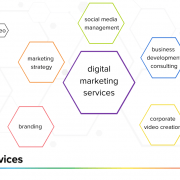Responding to spontaneous changes is not always easy. When people had to face the Corona pandemic and the resulting contact restrictions, the demands on modern technology skyrocketed. Companies suddenly had to find ways to hold meetings that were usually held at the company from home, business meetings had to be conducted online and trainings and education could no longer be held on-site due to the large number of participants. Solutions included conferencing tools like Zoom or Teams, e-learning platforms and AR and VR applications.
Augmented reality is already used in many companies for training or education purposes. In the context of AR, reality is combined with virtual reality; an overlay takes place. With the help of AR glasses or the cameras of tablets or smartphones, information such as videos and images with computer-generated additional information can be superimposed into the field of vision and an interaction is possible. For example, cars or airplanes no longer need to be disassembled, as all necessary objects can be superimposed into the field of view. Certain actions can also be performed on the object, since interaction is possible with the objects displayed in the field of view. This offers the advantage that difficult situations can be simulated in the virtual space and thus dangerous situations can be prevented. Errors, such as incorrect operation and resulting accidents or defects can be prevented and the company saves costs and effort. Considerable savings can also be made in training: If machines or devices have to be installed at the customer’s site, the employee in charge no longer has to travel all the way there but can guide him with the help of AR glasses. The operator who must install the machine, for example, sees helpful objects and images in his field of vision. The counterpart sitting in the offering company sees the same field of view and can mark and insert important things.
Another tool that has gained popularity is e-learning platforms. It can be used to exchange data and for testing and training employees. Especially at universities, those platforms are used to provide materials and to conduct tests and exams. Companies can use these platforms to conduct online training, for example, on the topic of IT security. Questions can be answered interactively by employees and the subsequent answers are analyzed and evaluated. In this way, it is possible to monitor and analyze performance. Weak points and possible areas for improvement can be identified.
Last but not least, conferencing tools like Zoom and Teams have become indispensable. Especially for large companies or universities, it was a challenge to provide a tool for several hundred people to communicate with each other via video within a short period of time. In some cases, hurdles in terms of data law have come up, as internal company information could not simply be shared online. Because of that, some companies have developed their own tools, which helps to counteract the problems.
The idea of holding meetings and trainings online that have typically been held face-to-face and travelled extensively for was at first unfamiliar for many companies. Over time, however, it became clear that this could save time as well as money and effort. Rethinking the importance of meetings was encouraged.
The Corona pandemic has acted as a catalyst for digitization in many companies. Opportunities were considered that had never been thought of before. There is a suitable solution for the needs of every company – it just has to be found!
Ready to use the latest technologies? Get in touch with us!












nice post
Augmented reality (AR) revolutionizes training and education across industries, offering a seamless blend of reality and virtual information. By superimposing digital content onto real-world environments through AR glasses or device cameras, companies optimize training processes and enhance safety. Complex tasks can be simulated, preventing accidents and reducing costs associated with errors. AR facilitates remote assistance, eliminating the need for on-site visits and streamlining training procedures. This innovative approach not only improves efficiency but also ensures consistent learning experiences. As AR continues to evolve, its applications in training underscore its transformative potential, making it a compelling topic for exploration in UK assignment help contexts, particularly in discussions on technological advancements and their impact on workforce development.